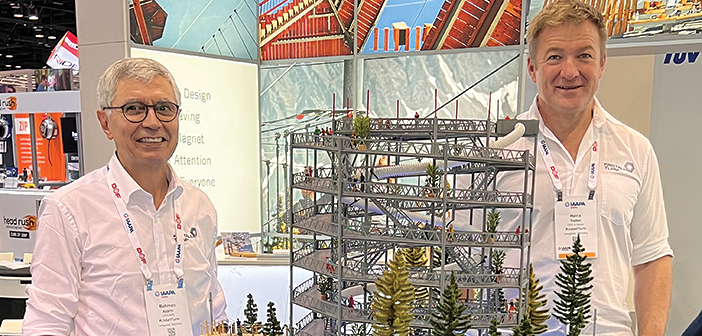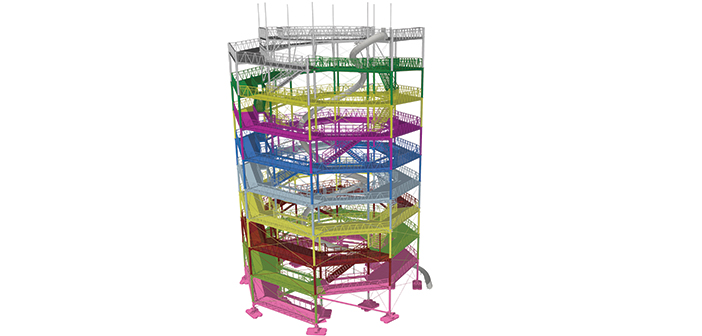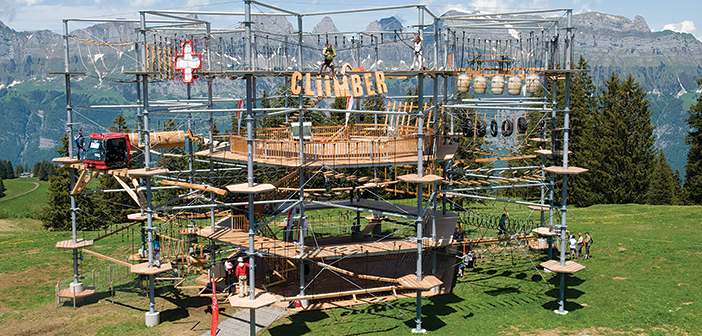Two adventure park innovators with Swiss roots, Bahman Azarm of Outdoor Venture Group and Heinz Tretter of KristallTurm, are collaborating on the Nautilus Tower, an accessible observation and adventure tower. Rising 115 feet high, the modular steel tower serves as the locus for a variety of add-on activities that can include zip lines, rappelling, slides, climbing walls, and more.

Outdoor Venture Group’s Bahman Azarm (left) and KristallTurm’s Heinz Tretter displayed a model of the Nautilus Tower at the IAAPA Expo.
Perhaps the most unusual feature of the tower, though, is the ramped path that winds around it, providing versatile access to the top for just about anyone. That path, along with the various challenges the tower incorporates, makes the tower more broadly accessible than a typical ropes course.
With construction soon to begin on a Nautilus Tower—the first of its kind in the U.S.—at OV’s The Adventure Park at Virginia Aquarium, API sat down to chat with Azarm and Tretter about the meeting of the minds that led to the creation of this new twist on adventure park construction and experiences.
API: You have a background in woodworking, Heinz. How did that lead you into the aerial adventure world?
Tretter: I was a ski teacher and I had a ski school which was growing, and I needed something else for the summer. So I built a ropes course with wooden poles, of course, because I was a carpenter. Other people came along and wanted the same thing, so I switched to a modular system, which makes it easier to transport and to preassemble everything.
Bahman was one of the biggest and most successful ropes course builders in the U.S.; he took notice through a [mutual]friend of ours.
Azarm: That was in 2012. I had heard about Heinz and the structures he was making, and at the time nobody else was doing that. I was very curious about how a ropes course would operate in a structure like that. We met in Vienna, and he drove me over to Hungary to show me the installation he had there. I had never seen a ropes course like that before, and it was quite amazing.
API: Bahman, what was it about KristallTurm that attracted you?
Azarm: Everything Heinz did had a tremendous attention to detail, down to the actual nuts and bolts he’s using. Heinz is so versatile in what he can build that we have been using KristallTurm more and more. He does things efficiently, he does them well, and he does so many things—we’re actually purchasing kids’ playgrounds from Heinz as well.
Tretter: We’ve built more than 60 ropes courses in more than 25 countries. We’ve diversified by adding children’s playgrounds, and Ninja and fitness parkours.
We have been really impressed with the facilities in the U.S. Entrance tickets are much higher than in Europe, but if the client is going to pay more, they also want to have more fun. And you can’t have more fun with only climbing elements. The Nautilus Tower is something special and out of the box.
Azarm: I had been following Heinz on all the installations he was doing around the world, and they were essentially the Nautilus Tower in a different form. The columns were all there, but instead of being a ropes course, they were essentially a walkway that goes up. So I knew he had the capability to build what I wanted.
One of the things that was really helpful was that the engineer Heinz used, Thomas Liebmann, had been building towers before he switched to constructing some of the biggest zip lines in the world. When we asked him if he’d engineer the Nautilus Tower, he was interested because it was so unique.
API: Tell us about your background and how it brought you to build what’s essentially an all-purpose fun tower?
Azarm: My education is that I’m a soil scientist, but I also worked for a while as an engineer, designing and building agricultural equipment. Fast forward, I had a small construction firm and got into building ropes courses, and I was always looking at different ways they could be built. When I met Heinz, I always knew there would be some kind of collaborative work coming up.
I grew up in Switzerland and went to an Outward Bound type school. In 2006, at a reunion we went to a local adventure park, which was owned by a friend of a friend. I got introduced [to the industry]and that led to my building my first course at Catamount Mountain Resort [in upstate New York]. My construction firm went from building houses to building platforms and cables on trees.
API: How long has Nautilus Tower been around?
Azarm: It’s been manufactured for about a year, but it is still waiting to be shipped into the U.S. to be assembled. We’re just waiting for the last permits. But our collaboration in manufacturing began a few years ago.
We’re leasing the land from the Virginia Aquarium; we built an adventure park there in 2014, but always planned a second phase, which became the tower.

The Nautilus Tower is designed to have a low-impact footprint.

More than 20 optional activities can be added to a Nautilus Tower.
API: Why the name Nautilus Tower?
Azarm: We wracked our brains on what to call it, but when you look at a nautilus shell, it’s a spiral, like the tower’s staircase. And we thought the name was apropos at Virginia Beach since it’s by the water.
API: Heinz, what makes KristallTurm so well suited to manufacture the Nautilus Tower?
Tretter: I started working with an engineer in 2008 or 2009, and the general design is still the same. You need a company that not only can take the plans and go down to the workshop and build it, but also work on a large scale, because the tower is huge—180 tons. The handrail alone from bottom to top is 3 tons.

A KristallTurm activity tower, a near relative of the Nautilus Tower, at Flumserberg, Switzerland.
API: Can you build this from the ground up?
Azarm: In our Virginia Beach location, there’s no road. So all pieces have to be brought in by ATV over a little bridge, and we designed a little crane for assembly. The crane has been designed so that it fits on the main poles of the structure. It has a winch on it and goes down and picks up a piece, and moves itself to the next column. So, it builds itself. >>
When Heinz first designed the metal structure with the engineer, that’s essentially all they were doing. When we first met, the manufacturing facility was quite small. Now he has three buildings, with these automatic welders and machines. While the towers are steel, he’s also doing wooden playgrounds, and so he can build some of the wooden elements we need, too.
API: Explain the modularity of the Nautilus Tower.
Tretter: We wanted to be able to build in other locations using standardized measurements for the steel pipes. You screw it together on the ground, lift it up and assemble the parts around it. The general idea is to always build it the same way, in sections of about 40 feet.
In the case of Virginia Beach, however, because we only had this little access road, we had to make everything smaller—15 feet instead of 40 feet. So we can customize when we need to.
We have this expensive mainframe, so we want to put a lot of things on it. We now have more than 20 options that you can add to the tower. We have a multifunctional frame, not just a ropes course.
API: Bahman, talk to us about going up instead of out when building courses like the Nautilus Tower. How did you go from building ropes courses to a tower?
Azarm: In Europe about 10 years ago, I encountered an observation tower similar to the Nautilus Tower. It’s always been in my mind, what’s the next thing that people are going to want to do?
One of the limitations we have with a ropes course is how young a child can use it. We can go down to 5-year-olds fairly easily, but cannot hit that 2- to 3-year-old market, or people in strollers or wheelchairs.
The observation tower, I believe, is the next product that will be built throughout the world. There’s about 20 of them in Europe now, and they are really available to the whole family.
What I was interested in is having a tower that could really do multiple things. The tower is great because once you get to the top, you’ll be able to see the ocean and the Navy jets taking off and Virginia Beach. And you’ll have a slide coming down.
But it’s not really all about the thrills, it’s about the family being able to do something all together.
API: How many people do you need to operate the tower?
Azarm: It’s very simple actually; you can have automated gates at the beginning and use RFID like at ski lifts. Major staffing would be for the slide—one at the top, another at the bottom. Plus some sort of security. The slide would be a separate admission.
API: What is the potential with this structure that you didn’t have before?
Azarm: At one time, I think, everyone was focused on the idea of a thrill tower, something you can jump off or zip line off. Fast forward 10 years, and we see that very few people want to jump off a 100-foot tower. So we went from there to a tower that everyone can climb and use and enjoy.
We went through many different designs, but they needed a lift to bring people up. Then I saw a picture of the Guggenheim Museum in New York, and that’s when it hit me that what we needed was a ramp that goes around and around and gives everybody accessibility.
We’re really excited about the design, the simplicity of manufacturing it, the modular construction, and the fact that it really can be built anywhere.
API: Are there any elements that you can or can’t use in a tower that you could in the woods?
Azarm: It’s not very similar. When you get to about 40 feet on the tower at Virginia Beach, there’s a canopy walkway that goes out into the trees. It’s a 38-acre property, so the walkway comes to and from the tower in a giant loop that includes four themed treehouses for kids.
One thing that is similar to building in the trees is that there will be a rope walkway, but no harnesses. The canopy walk does move a little, but it’s really to go out there and spend the day and see the landscape from 40 feet up.
API: Heinz, how does the Nautilus Tower compare to what you’ve built in Europe?
Tretter: Our other projects are mostly smaller ropes courses and platforms for corporate events, birthday parties. Still, there are so many things that people can do on these platforms. In China, we’ve built them with shading, and some have DJs and dance floors. But Nautilus Tower is double the size of what we’ve done before.
Azarm: There are two sets of staircases on the tower, so one could have different elements coming down—slide down to a lower level, ropes course elements that don’t require a harness. There are really interesting things to do that Heinz has done, but we tried to keep it simple for the first one.
API: Integration between the natural environment and the tower seems to be particularly important for the Virginia Beach site.
Azarm: We have talked about being able to see the ocean—what we haven’t talked about is being able to see the top of the trees. You’re in the woods and then above the woods, and it’s really an amazing experience. The tower is 65 feet wide and 115 feet tall. The footprint is pretty small, so it requires very few trees to be removed. We want people to enjoy the outdoors and trees are part of that. It’s very different, very zen compared to the adventure park side.
API: To what extent is Virginia Beach a proof of concept for building towers in the U.S.?
Azarm: The proof of concept has already been done in Europe. It’s the first one in the U.S., it’s the most expensive project we’ve done, but it’s something that I’ve wanted for a long time. It’s a wish come true.
API: Have you put a price tag on it?
Azarm: For us it’s going to be a $5 million project, which we will own. Absolutely we would be willing to build for other people. I think, for example, it would be a great thing for Cape Cod, or some parts of Connecticut or Rhode Island where you have a view of the ocean.
I think it’s really important to have the view. Ski areas could put it on top of their mountain, or different areas where you can get views. I think it would be a terrific summer activity, because they already do hiking, and this is kind of a condensed version of hiking.
API: Any kind of mental wish list of cool elements you’d like to see on the tower?
Azarm: We have talked about climbing the outside of it or having it be open to runners, because nothing in Virginia Beach has any kind of hill to it. We also had the dream of making the pathway up into a light show, which would make it a very interesting night activity, and then you get to the top and see the lights of Virginia Beach.
The path is wide enough for ATVs, and maybe BMX bikers could have access to it at certain times of day, and use it and the canopy walkway as well. A via ferrata walk around the outside of the structure is another idea.
Tretter: In five years, the Nautilus Tower will be completely different. We will have so many attractions—bouncing nets, abseiling [rappelling], zip lines. Once it’s done and it runs smoothly, we’ll be bored and ready to add more (laughs).






